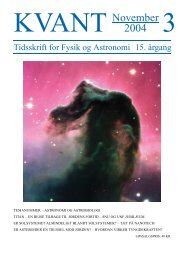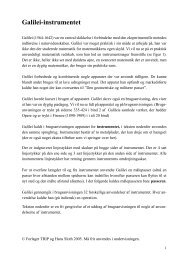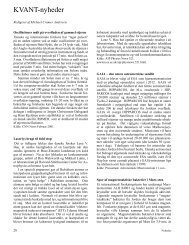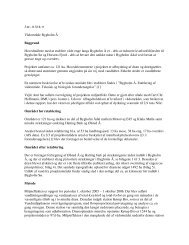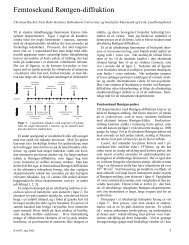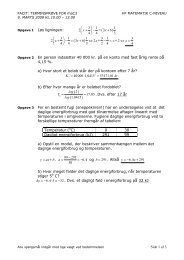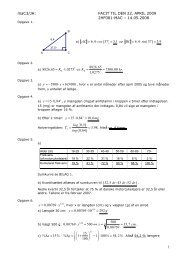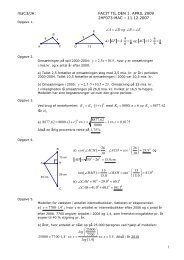Chapter 7 The Outer Planets
Chapter 7 The Outer Planets
Chapter 7 The Outer Planets
You also want an ePaper? Increase the reach of your titles
YUMPU automatically turns print PDFs into web optimized ePapers that Google loves.
200 <strong>Chapter</strong> 7 <strong>The</strong> <strong>Outer</strong> <strong>Planets</strong><br />
a b<br />
FIGURE 7-13 Ganymede This side of<br />
Ganymede is dominated by a huge, dark, circular<br />
region called Galileo Regio, which is the largest<br />
remnant of Ganymede’s ancient crust. Darker areas of the moon are<br />
older; lighter areas are younger, tectonically deformed regions. <strong>The</strong><br />
white areas in and around some craters indicate the presence of water<br />
WEB LINK 7.12<br />
VIDEO 7.5<br />
perhaps are still in motion. Indeed, the chaotic surface revealed<br />
by Galileo is interpreted as having formed as a result<br />
of volcanism on Europa, strengthening the belief that this<br />
moon still has a liquid water layer. Replenishment of the<br />
surface by tectonic plate motion would explain why only a<br />
few small impact craters, such as the crater Pwyll (see Figure<br />
7-12), have survived.<br />
Europa’s average density of 2970 kg/m 3 is slightly less<br />
than Io’s. A quarter of its mass may be water. It also has a<br />
metallic core of much higher density. In 1995 astronomers<br />
discovered an extremely thin atmosphere containing molecular<br />
oxygen surrounding Europa. <strong>The</strong> density of this gas is<br />
about 10 –11 times the density of the air we breathe. <strong>The</strong> oxygen<br />
may come from water molecules broken up on the<br />
moon’s surface by ultraviolet radiation from the Sun.<br />
7-6 Ganymede is larger than Mercury<br />
Ganymede is the largest satellite in the solar system (Figure<br />
7-13). Its diameter is larger than Mercury’s, although its<br />
density of 1940 kg/m 3 is much less than that of Mercury. It<br />
also has a permanent magnetic field that is twice as strong<br />
as Mercury’s field. Ganymede orbits Jupiter in synchronous<br />
rotation once every 7.2 days. Like its neighbor Europa, Ganymede<br />
has an iron-rich core, a rocky mantle, a liquid water<br />
ocean, a thin atmosphere, and a covering of dirty ice.<br />
<strong>The</strong> existence of the ocean is implied by the discovery of<br />
a second, changing magnetic field around Ganymede that is<br />
generated by Jupiter’s magnetic field. As Ganymede orbits<br />
Jupiter, the planet’s powerful magnetic field creates an elec-<br />
ice. Inset (a) is about 46 × 64 km (29 × 38 mi). Note in this Galileo<br />
spacecraft image the deep furrows in the moon’s icy crust that<br />
probably resulted from crustal movement due to impacts and tectonic<br />
plate motion. <strong>The</strong> perspective in inset (b) was created by combining<br />
information from two Galileo images. (NASA/JPL)<br />
trical current inside the moon, which in turn creates Ganymede’s<br />
varying magnetic field. (<strong>The</strong> same effect is used to<br />
create electrical currents in electrical power stations here on<br />
Earth.) <strong>The</strong> best explanation of why the current flows inside<br />
Ganymede is that liquid salt water exists there; salt water is<br />
a good conductor of electricity. This implies, of course, the<br />
presence of a liquid ocean. Furthermore, salts have been observed<br />
on Ganymede’s surface. <strong>The</strong>y were apparently carried<br />
upward and deposited there as water leaked out and froze.<br />
Like our Moon, Ganymede has two very different kinds<br />
of terrain. Dark, polygon-shaped regions are its oldest<br />
surface features, as judged by their numerous craters. Lightcolored,<br />
heavily grooved terrain is found between the dark,<br />
angular islands. <strong>The</strong>se lighter regions are much less cratered<br />
and therefore younger. Ganymede’s grooved terrain consists<br />
of parallel mountain ridges up to 1 km high and spaced 10<br />
to 15 km apart. <strong>The</strong>se features suggest that the process of<br />
plate tectonics may have dominated Ganymede’s early history.<br />
But unlike Europa, where tectonic activity still occurs<br />
today, tectonics on Ganymede bogged down 3 billion years<br />
ago as the satellite’s crust froze solid.<br />
Another mechanism that may have created Ganymede’s<br />
large-scale features is a bizarre property of water. Unlike<br />
most liquids, which shrink upon solidifying, water expands<br />
when it freezes. Seeping up through cracks in Ganymede’s<br />
original crust, water thus forced apart fragments of that<br />
crust. This process could have produced jagged, dark islands<br />
of old crust separated by bands of younger, light-colored,<br />
heavily grooved ice. Topping off Ganymede’s varied features<br />
is the discovery that auroras occur there.




